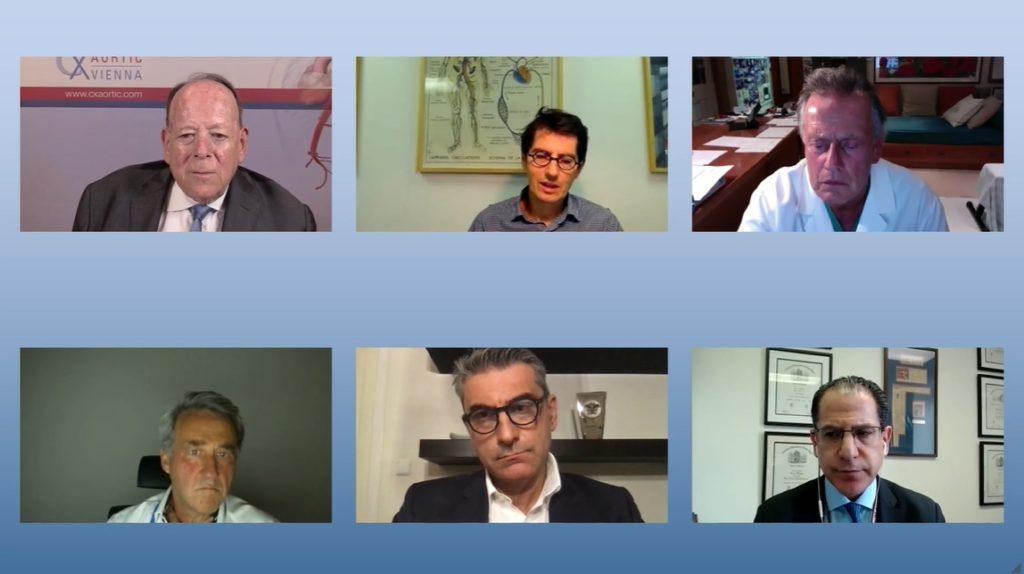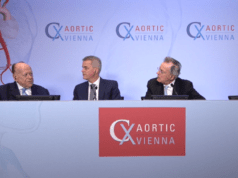
Use of a specifically designed stent graft to treat a fragile aorta was backed by three quarters of the CX Aortic Vienna audience, polled during a session on the timing of intervention in thoracic aortic dissection.
Stéphan Haulon (Paris, France) and Roberto Chiesa (Milan, Italy) moderated the discussion, during which the audience viewed an edited case involving a new stent graft, the Valiant Navion (Medtronic), designed with specific features for fragile aorta pathologies. Attendees also heard during the session that timing of thoracic endovcascular aortic repair (TEVAR) is a “balance between early procedural risk and promotion of aortic remodelling,” while the merits of early intervention were also considered.
Opening the session, Mark Farber (Chapel Hill, United States) addressed several misconceptions and controversies concerning the treatment of chronic type B aortic dissection, in a presentation on the management of chronic dissections with fenestrated or branched endovascular aortic devices.
Farber challenged the assertions that TEVAR alone is successful in treating the condition, that small true lumen will not allow expansion of devices, and that problems exist if the natural fenestrations are not aligned or small. He also presented data comparing endovascular outcomes of post-dissection and degenerative thoracoabdominal aneurysms.
Ali Azizzadeh (Los Angeles, United States), gave CX Aortic Vienna attendees a detailed overview of the parameters for understanding windows of success in type B aortic dissection. During the presentation he outlined recently revised temporal classifications of aortic dissection, discussed the predictors of intervention and mortality in patients with uncomplicated acute type b and considered research on the influence of timing after thoracic endovascular aortic repair for acute type B aortic dissection. Taking all of the evidence together, he concluded that there is growing evidence that optimal timing of TEVAR decreases risk of complications.
According to Ian Loftus (London, United Kingdom) timing of TEVAR is a balance between early procedural risk and promotion of aortic remodelling. In his presentation, Loftus made a case for reviewing the timing of intervention for type B dissections, and called for more treatment of the condition during the acute phase. Many practice delaying TEVAR until a subacute period, he said, noting that this has significant implications for services and resources. Loftus discussed data on the timing of TEVAR—taken from the VIRTUE Registry—showing that intervention in the subacute period had a 0% mortality rate, compared to 8% in the acute phase. In his concluding remarks, Loftus said: “Contemporary data supports more intervention in the acute phase.”

Frank Vermassen (Ghent, Belgium) focused his presentation on whether early treatment of aortic dissection could be considered as a definitive solution. It is generally accepted that in acute type B dissection there should be a difference between complicated and uncomplicated cases, he remarked. Continuing pain, acute dilatation or expansion, branch vessel malperfusion and rupture are classically considered as indications for early intervention, Vermassen added, noting that findings from the INSTEAD XL study show that even after TEVAR, progression of the disease occurs in almost 30% of patients. Vermassen opened the ensuing discussion by concluding that early treatment of aortic dissection is not a definitive solution.
In his presentation, Theodoros Kratimenos (Athens, Greece) discussed the treatment of the fragile aorta, presenting an edited case involving the Valiant Navion device. He noted that there is a clinical need for an endograft with specific features to treat broad aortic pathologies, and he discussed the features and configurations of the Valiant Navion device and its particular features for fragile aorta pathologies. Kratimenos commented that the device is a suitable choice for the treatment of fragile aortas, minimising disruption to the native vessel, but said that a post market registry will be started to better understand outcomes regarding these complex patient populations.
Data on the effectiveness of the Valiant Navion device in the fragile aorta was then picked up in the following presentation, in which Ross Milner (Chicago, USA) discussed existing studies to have assessed the device and detailed the ongoing DISSECT-N Global TEVAR Registry, which will enrol around 200 subjects, to be followed for three years post-procedure.













